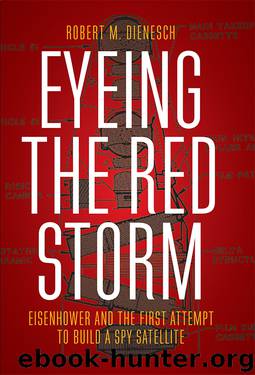Eyeing the Red Storm by Robert M. Dienesch

Author:Robert M. Dienesch [Dienesch, Robert M.]
Language: eng
Format: epub
Tags: HIS036060 History / United States / 20th Century
ISBN: 9780803286757
Publisher: UNP - Nebraska
Published: 2016-01-21T16:00:00+00:00
Film Return, Project II-A, and the CIA’s CORONA (November 1957–February 1958)
Even as Lockheed was drawing up plans for expediting the WS-117L, forces beyond its control were eclipsing its efforts. The RAND design proposal had circulated within the air force and among senior scientific advisors in the White House in November 1957. The ideas behind RAND’s drop-film system had appeared in the October 1957 evaluation of the WS-117L program by the President’s Board of Consultants, and the most vocal proponents of a dramatic change in the program, Killian and Land, strongly endorsed the idea.
Eisenhower took heed of their advice and on October 28, 1957, had his executive secretary advise Secretary of Defense McElroy and CIA Director Allen Dulles that he wanted a joint briefing on the status of advanced reconnaissance systems. Because the issue was so sensitive, McElroy (speaking on behalf of Dulles and himself) proposed oral briefings with no written records. Always security conscious, the president agreed. What is clear is that during this blackout period, running from December 5, 1957, until roughly February 28, 1958, the chief executive decided that the program needed major changes.48
The alteration occurred in absolute secrecy. On February 6, 1958, Killian and Land met with Dulles, McElroy, and Quarles to discuss a new proposal for a film-return satellite. The following day they met again to brief Eisenhower. They proposed removal of those portions of the WS-117L program that promised the most rapid success—namely the film-return satellite (Lockheed’s Program II-A)—for independent development.49 Unlike the WS-117L program, this was not a “pie-in-the-sky” scheme; Land made it very clear that it was a “specific small project for bona fide intelligence purposes.”50
To be effective the whole program had to be as covert as possible, hiding “under the cloak of other activities” to reduce the political ramifications of a reconnaissance satellite. There was, however, a technical and strategic reason for this as well. The resolution of the initial camera system was likely to be inferior to that of the U-2 (resolution of fifty to one hundred feet, as opposed to approximately six inches for the U-2 Baker camera). Careful precautions were essential to guard against Soviet discovery of the spy satellite; the Soviets could easily deceive and confuse American photo interpreters with dummies and camouflage. Fortunately the capsule radiated no signals, so the greatest threat to its covert nature lay in espionage or leaks during development and operation. Land and Killian called for joint air force–CIA production, with the air force dominant—an idea that Eisenhower rejected. He favored putting the CIA in complete and exclusive control of all the intelligence phases, with as few people as possible knowing about it.51
Eisenhower’s distress over satellite management lay behind his insistence on CIA control. The military, particularly the air force, appeared to concentrate more on lobbying for funds than on producing the reconnaissance satellite it was already developing. All three services had advocated their own brand of space program in the wake of Sputnik, with the army’s virtually identical to the WS-117L system.
Download
This site does not store any files on its server. We only index and link to content provided by other sites. Please contact the content providers to delete copyright contents if any and email us, we'll remove relevant links or contents immediately.
| Aerodynamics | Aircraft Design & Construction |
| Astronautics & Space Flight | Avionics |
| Gas Dynamics | Propulsion Technology |
Whiskies Galore by Ian Buxton(40292)
Introduction to Aircraft Design (Cambridge Aerospace Series) by John P. Fielding(32329)
Small Unmanned Fixed-wing Aircraft Design by Andrew J. Keane Andras Sobester James P. Scanlan & András Sóbester & James P. Scanlan(32135)
Craft Beer for the Homebrewer by Michael Agnew(17439)
Turbulence by E. J. Noyes(7031)
The Complete Stick Figure Physics Tutorials by Allen Sarah(6630)
Kaplan MCAT General Chemistry Review by Kaplan(6044)
The Thirst by Nesbo Jo(5778)
Bad Blood by John Carreyrou(5760)
Learning SQL by Alan Beaulieu(5399)
Weapons of Math Destruction by Cathy O'Neil(5029)
Man-made Catastrophes and Risk Information Concealment by Dmitry Chernov & Didier Sornette(4728)
iGen by Jean M. Twenge(4693)
Digital Minimalism by Cal Newport;(4509)
Life 3.0: Being Human in the Age of Artificial Intelligence by Tegmark Max(4492)
Audition by Ryu Murakami(4091)
1,001 ASVAB Practice Questions For Dummies by Powers Rod(4034)
Electronic Devices & Circuits by Jacob Millman & Christos C. Halkias(4019)
Pale Blue Dot by Carl Sagan(3995)
